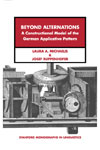

|
|
|
|

Beyond AlternationsA Constructional Model of the German Applicative Pattern Alternations play a central role in most current theories of verbal argument structure, which are devised primarily to model the syntactic flexibility of verbs. Accordingly, these frameworks take verbs, and their projection properties, to be the sole contributors of thematic content to the clause. Approached from this perspective, the German applicative (or be-prefix) construction has puzzling properties. First, while many applicative verbs have transparent base forms, many, including those coined from nouns, do not. Second, applicative verbs are bound by interpretive and argument-realization conditions which cannot be traced to their base forms, if any. These facts suggest that applicative formation is not appropriately modeled as a lexical rule. Using corpus data from a diverse array of genres, Michaelis and Ruppenhofer propose a unified solution to these two puzzles within the framework of Construction Grammar. Central to this account is the concept of valence augmentation: argument-structure constructions denote event types, and therefore license valence sets which may properly include those of their lexical fillers. As per Panini's Law, resolution of valence mismatch favors the construction over the verb. Like verbs of transfer and location, the applicative construction has a prototype-based event-structure representation: diverse implications of applicative predications--including iteration, transfer, affectedness, intensity and saturation--are shown to derive via regular patterns of semantic extension from the topological concept of coverage. is an assistant professor in the Department of Linguistics and a faculty fellow in the Institute of Cognitive Science at the University of Colorado at Boulder. is a doctoral student in the department of linguistics at the University of California, Berkeley, and a lexicographical researcher for the FrameNet project at the International Computer Science Institute in Berkeley. Contents
9/1/2001 ISBN (Paperback): 1575863308 (9781575863306)
Subject: Grammar; Verb phrase; Syntax and semantics |
Distributed by the
University of Chicago Press |
|
pubs @ csli.stanford.edu
|
CSLI Publications
Stanford University Cordura Hall 210 Panama Street Stanford, CA 94305-4101 (650) 723-1839 |